Affiliate disclosure: This post may contain affiliate links. Please see our Privacy Policy.
Chicken of the woods mushroom is a common, easy-to-identify edible wild mushroom that’s perfect for beginning foragers.
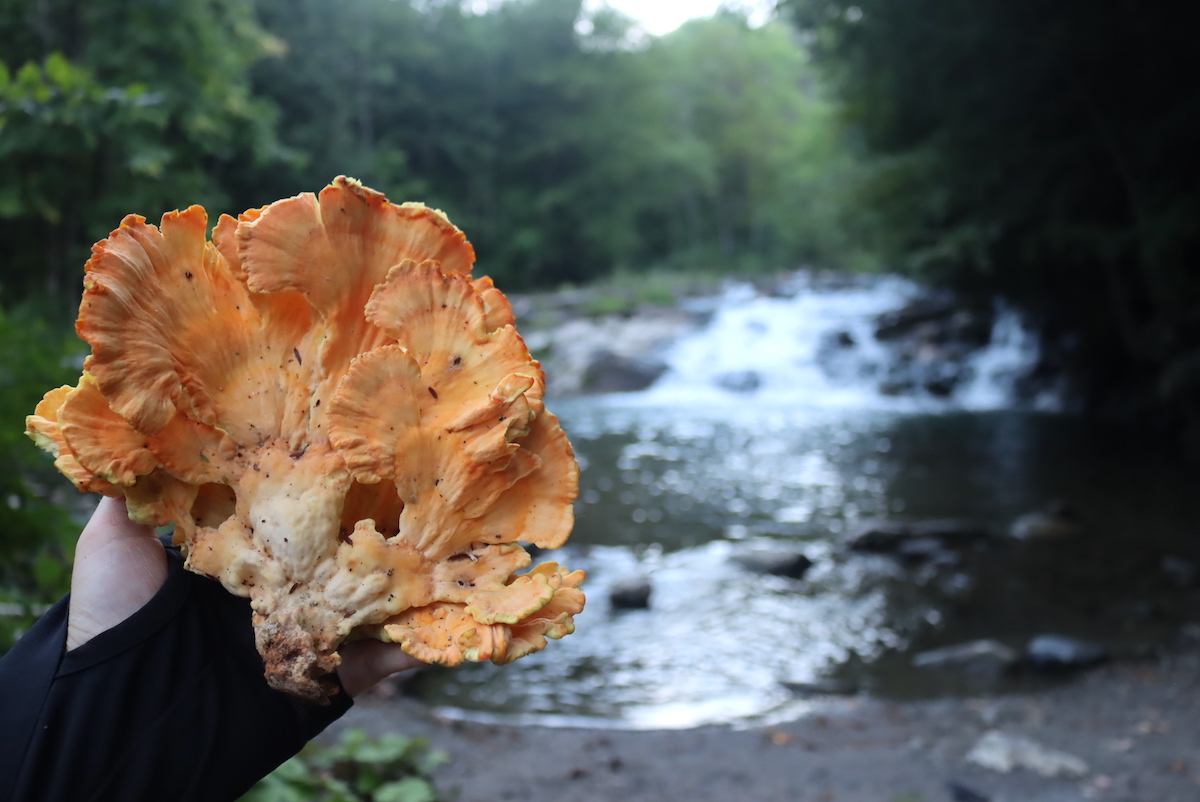
Chicken of the woods mushrooms are a common summertime sight, provided you spend any time in the woods during the hottest part of the year. Once you find them, they’ll always be there, in that same spot year after year, until the tree they’re growing from is little more than dust.
Last year, we found ourselves desperate for a bit of relief from record-high summer temperatures here in Vermont. True, it’s nothing like the south, but 96 F and near 100% humidity is a lot to ask of a people that are more prepared for the six months of winter we endure here in our northern climate.
We’d normally hit up our favorite swimming holes back in the woods, but this time the kids were desperate to try out the new community swimming pool that had just opened up in the next town over. We packed up towels and snacks and headed out…only to find in the kerfuffle of 2021, there wasn’t staff to open the pool. It sat there full of water, but with a locked gate…empty for lack of lifeguards and ticket takers.
We weren’t the only ones disappointed that day, and there were dozens of cars in the parking lot full of disappointed kids.
An old man on a bench out front came to our rescue and told us about an old forgotten swimming hole on a trail half a mile through the woods. We’re used to swimming holes, and the pool would have been a rare novelty, so off through the woods we went, excited to check out the new spot. (There were no other takers, as apparently, it’s chlorinated pools or nothing for the majority of families these days.)
A short way into the woods, my daughter squealed with delight, “Ice cream mushrooms!” and pointed up the embankment. I know, that’s a weird one…but we actually do make ice cream with mushrooms. Chanterelles have a flavor like fresh apricots, and ever since we made chanterelle ice cream my daughter’s constantly scanning the woodland landscape for splashes of orange color. (Good way to train little ones to help mama forage, am I right?)
They were pretty far off the trail, but I could see that big patch of orange in the distance too, so we scrambled up the embankment to find a beautiful patch of orange mushrooms…but not chanterelles. These were Chicken of the Woods!
We packed up a whole sack of them, nearly 30 pounds…and still left more in the woods that we took. These are really prolific when they get going. (And impossible to overharvest, so enjoy!)
A few minutes later we arrived at the swimming hole to find another summer treasure…cascading waterfalls down to a calm pool. The absolute perfect spot, and infinitely better than the community pool.
Even without chicken of the woods mushrooms on offer right along the trail, we’d be back here every summer, but now we have an extra incentive. Once you find a tree that bears chicken of the woods mushrooms, you can come back to that very same spot year after year.
See what happens when you take the path less traveled by?
(If you haven’t found a log that produces chicken of the woods mushrooms this year, don’t worry. They are available online from foraged market (in season), along with a great selection of other hard-to-find wild mushrooms and other wild edible plants and fruits.)
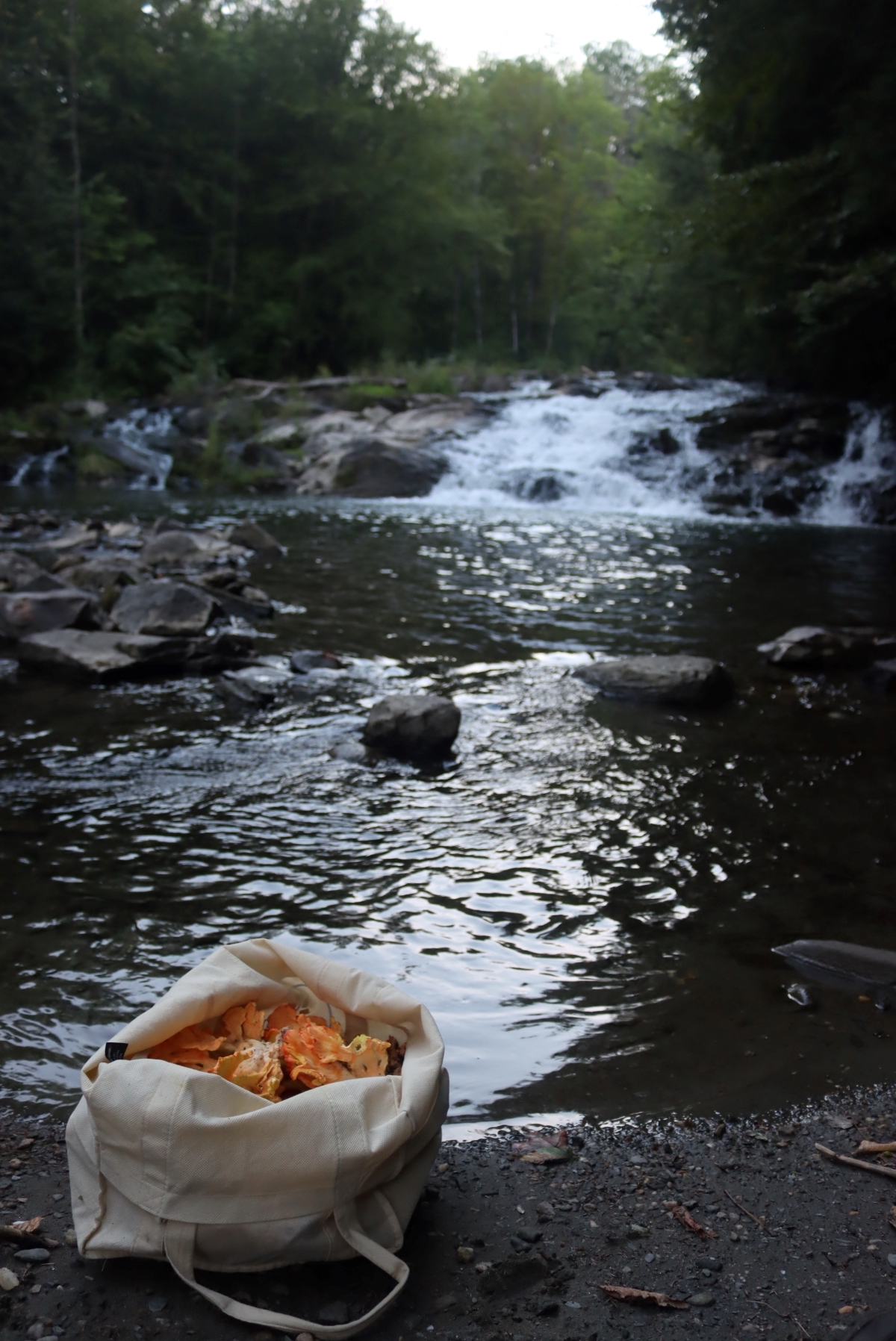
What are Chicken of the Woods Mushrooms?
Commonly known as Chicken of the Woods, chicken mushrooms, chicken fungus or sulpher shelf, they’re a decomposing mushroom (saprophytic) that lives on dead and dying wood. You’ll often see them on standing trees that appear otherwise healthy, but they’re a clear indicator of rot and once present, that tree is not long for this world.
All mushrooms in the laetiporus genus are known as “chicken of the woods” but the most common, at least here in the northeast, is Laetiporus sulphureus. There’s also Laetiporus cincinnatus, which is very similar but has lighter coloration, and Laetiporus conifericola which grows on conifers.
Where (and When) to Find Chicken of the Woods Mushroom
Chicken of the woods mushrooms grow on dead or dying wood, usually oak, but occasionally other hardwood species as well. There is a specific species that grows on conifers as well.
They tend to appear in the late spring to early autumn, depending on your location. Warmer spots further south will see them in spring, and cooler locations might not see them until August/September.
Rainfall also helps them develop, as with most mushrooms, but they’re generally more dependable in dry years than other mushroom species. You’ll see some sprout even during periods of extended drought, when other mushrooms are taking the year off.
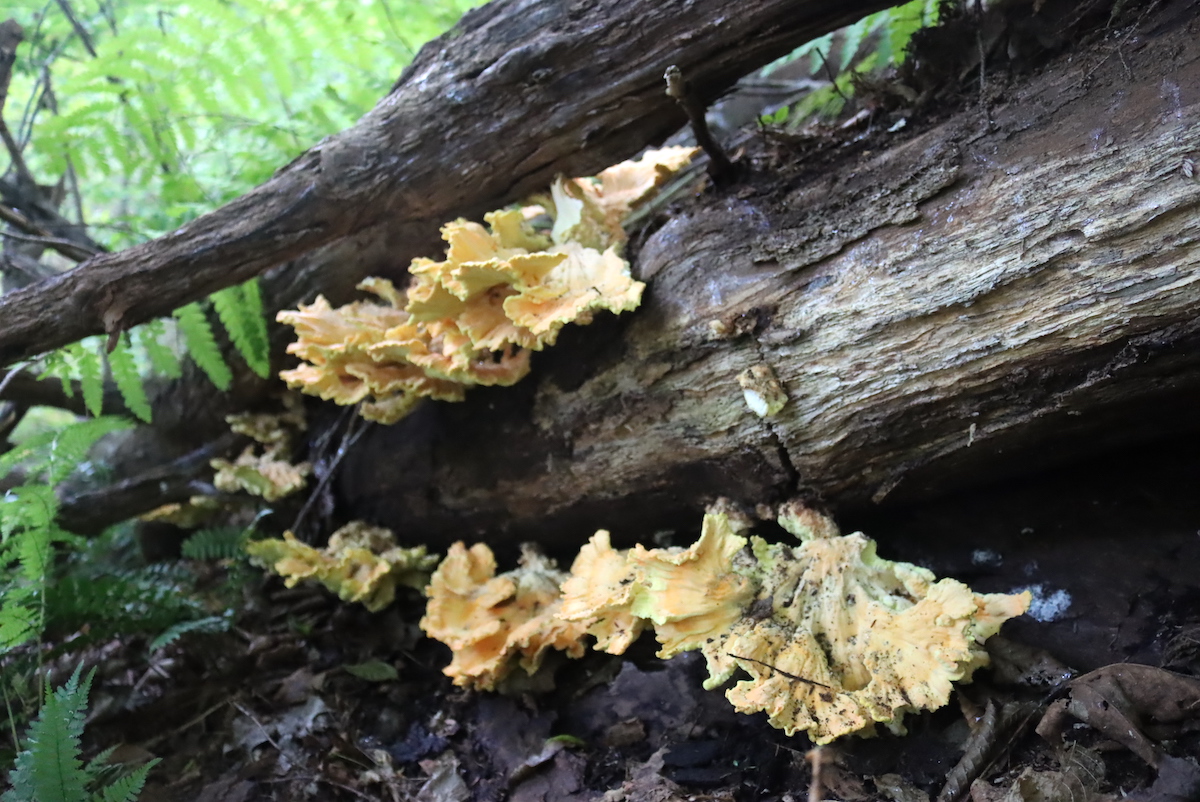
Chicken of the Woods Identification
The unmistakable yellow-orange color of chicken of the woods mushrooms is easy to see at a distance, and it’ll catch your eye in an otherwise brown/green woodland landscape.
The name “sulfur shelf” gives you an indication of its visual characteristics, as it has a yellow/orange color (like sulfur) and grows in shelf-like clusters on either standing or fallen wood. The “shelves” will be parallel to the ground, unless the tree has just very recently fallen.
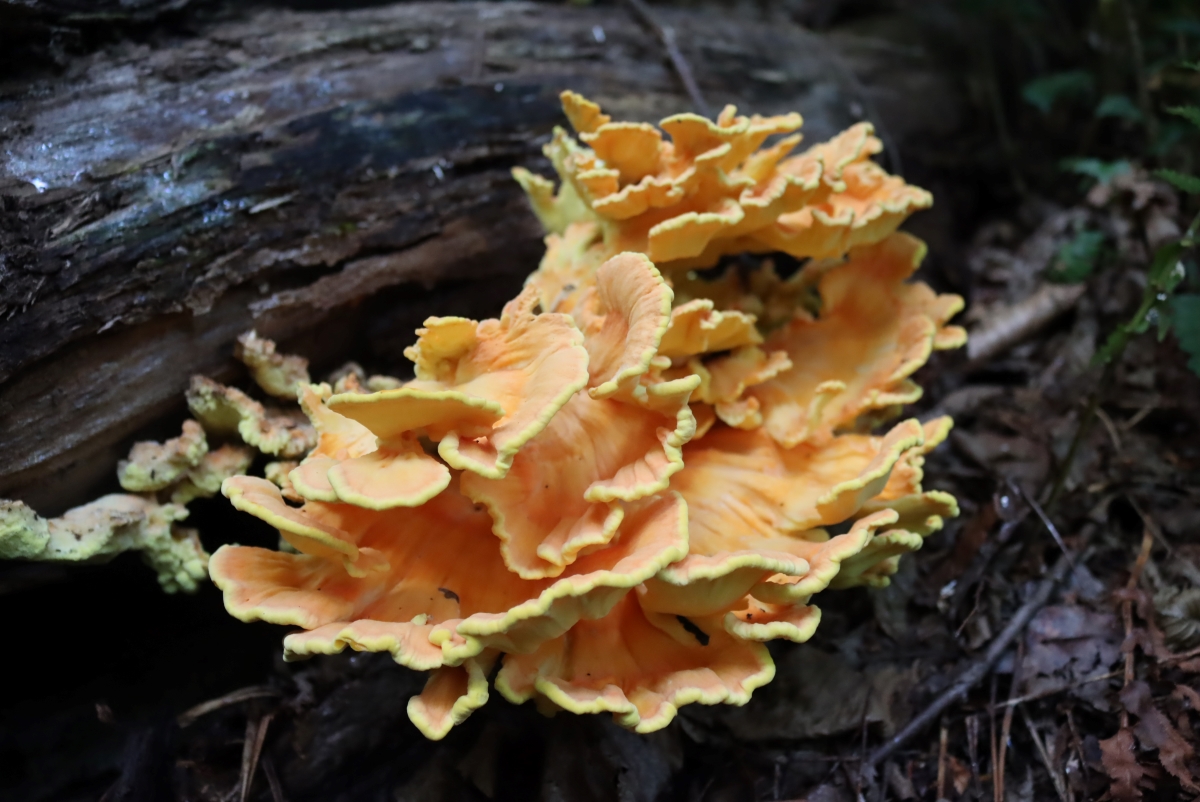
Generally, chicken of the woods mushrooms have an orange/yellow upper surface, and a bright yellow “sulfurous” underside.
A key identifying characteristic is the lack of gills on the underside. Instead of gills, you should see many tiny, nearly microscopic pores in the bright yellow under the surface.
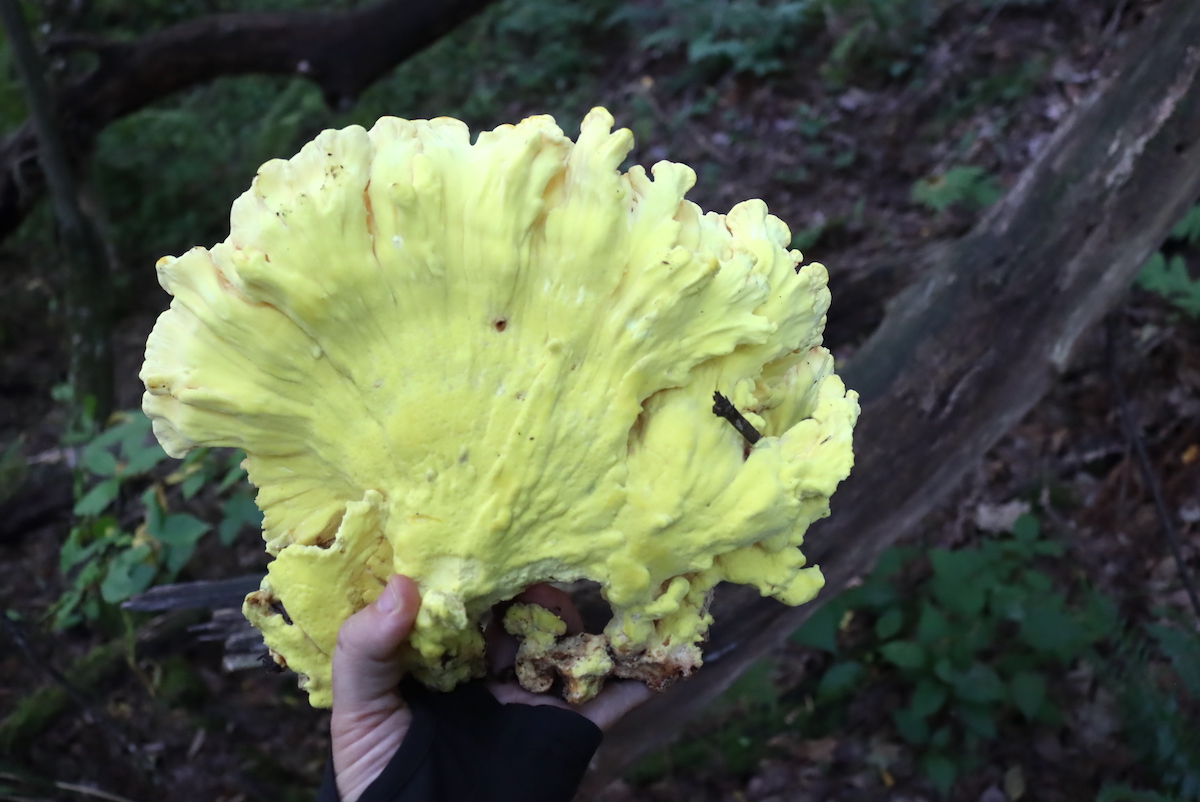
If you look REALLY closely, you can actually see the pores, but at a casual glance, it looks more like very fine fuzz.
Either way, when they’re in prime condition, the underside or pore surface will be a bright yellow.
The pores release spores, and that’s how the mushroom reproduces. It’s a polypore mushroom, like reishi, turkey tail, tinder polypore, and birch polypore.
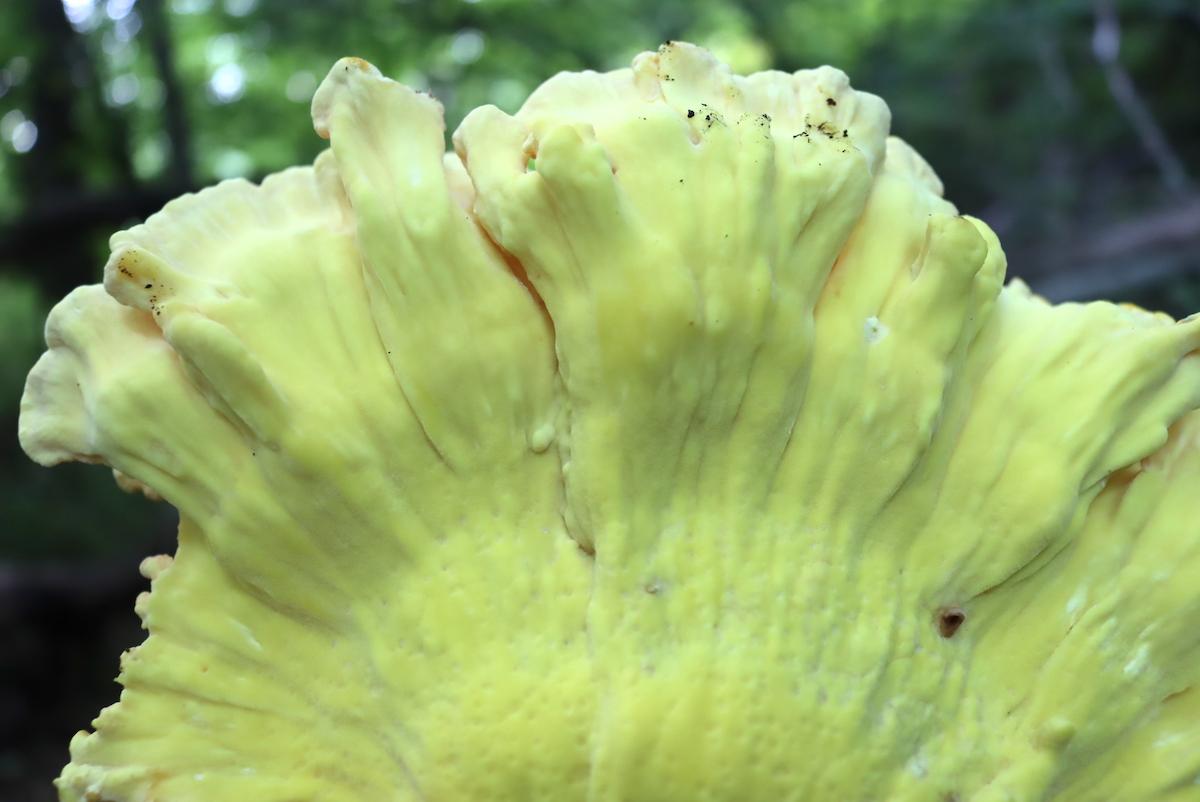
The color tends to fade when they’re past prime, and they’ll wash out to a more white-ish color.
Occasionally I’ve found that they don’t have the bright orange coloration on the top, when they’re in a place that’s protected from sunlight. There was a small space inside/under this log that had good quality chicken of the woods mushrooms with a slightly off-white to cream-colored top since they didn’t have sun exposure, but the pore surface was still a bright yellow sulfur color.
The leading edge of chicken of the woods mushrooms tends to be a bit thicker than the rest, and has a small yellow-ish ridge.
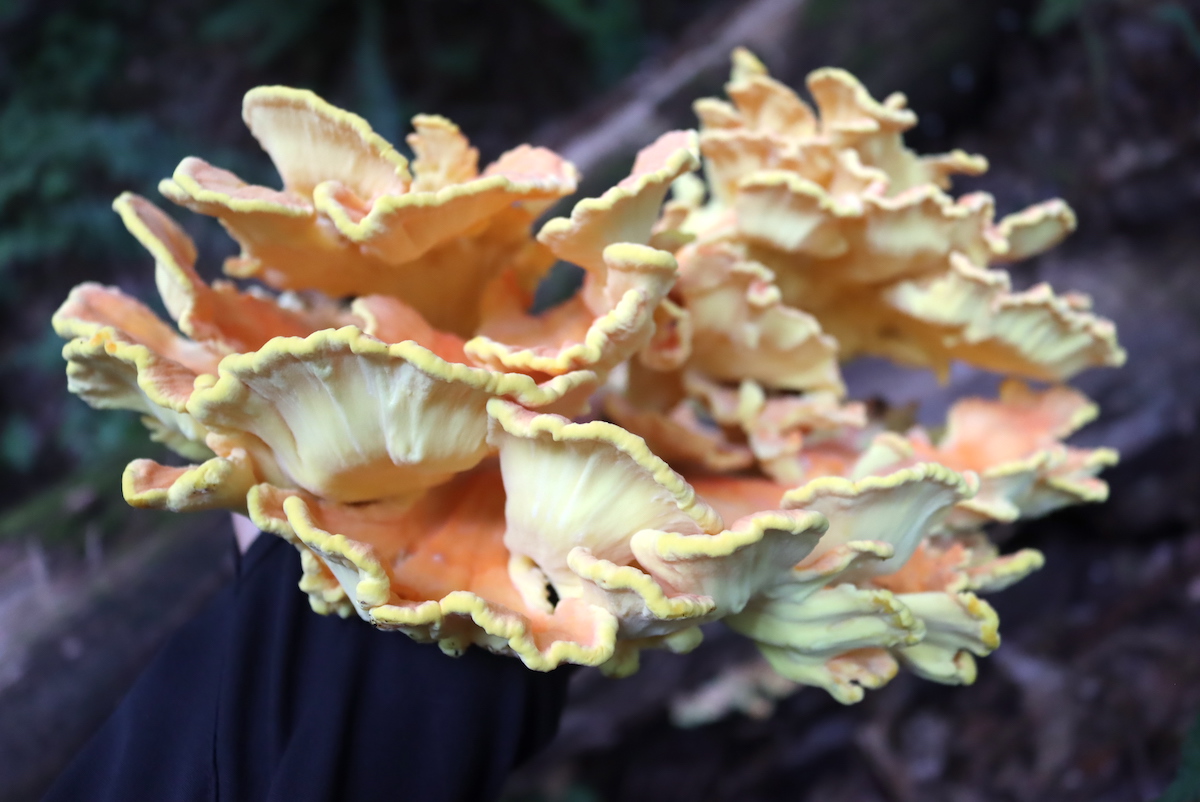
Chicken of the Woods Look-Alikes
As an easy-to-identify beginner mushroom, there’s nothing that really looks like chicken of the woods mushrooms. You won’t exactly find a “false chicken of the woods” out there, so don’t worry.
Occasionally it’s confused for other orange mushrooms, like chanterelles…but only from a distance. Chanterelles grow out of the ground, and not in shelf-like clusters on wood. They also have an orange underside with ridges, rather than a pore surface. (They’re also, edible, of course.)
Obviously, you’ll want to look out for orange chanterelle look likes, namely jack o lantern mushrooms (Omphalotus olearius), but those have gills, and don’t grow in a shelf-like way.
I’ve heard some people describe Velvet Top Fungus as a false chicken of the woods, but at least from the descriptions, the resemblance is superficial. It does grow in shelf-like clusters, and resembles a chicken of the woods in shape.
Personally, I’ve never come across velvet top fungus, but here’s a description from Nothern Woodlands:
“A velvet top fruiting body tends to be quite wet and squishy, often dripping water. The underside has irregular pores, is greenish when new, and turns red-brown when bruised. As a velvet top ages, the whole thing becomes brittle, turns brown, and looks like a cow pie.”
There you have it, avoid anything that looks like a squishy cow pie, and make sure the underside is a bright yellow.
Chicken of the Woods vs. Hen of the Woods
The name of Chicken of the Woods is somewhat similar to another edible mushroom called “Hen of the Woods,” though they look and taste nothing alike.
Chicken of the Woods is named because of its flavor, and it tastes an awful lot like chicken when cooked. It’s actually made into a darn good vegan fried chicken.
Hen of the Woods, on the other hand, is named for its appearance. It has a frilly, feathery appearance that looks like a fluffy chicken butt. It doesn’t taste like chicken, but instead, it looks like a chicken bent over and pecking at the base of a tree.

Harvesting Chicken of the Woods Mushrooms
Generally, chicken of the woods mushrooms pull away easily from the tree and you don’t need any special equipment (ie. a mushroom knife) to get them off. Grasp firmly, and pull.
They’re growing on dead, decomposing wood, so the wood may powder apart as well.
Chicken of the woods mushrooms are an incredibly common decomposer, and they’ll eventually be found on just about any dead oak tree. Don’t worry about overharvesting, they generally come in by the bucketful and will keep coming year after year until there’s no tree left.
They do tend to get past prime within 2-3 days, so there’s a pretty small harvest window once you see them fruiting. If you don’t happen to have a bag to harvest, be sure you come back the very next day to get them of you might just miss them.
Chicken of the woods mushrooms tend to get pretty dirty when they’re growing near the ground on fallen trees. They’ll need a bit of washing before you cook them, and watch out for slugs too.
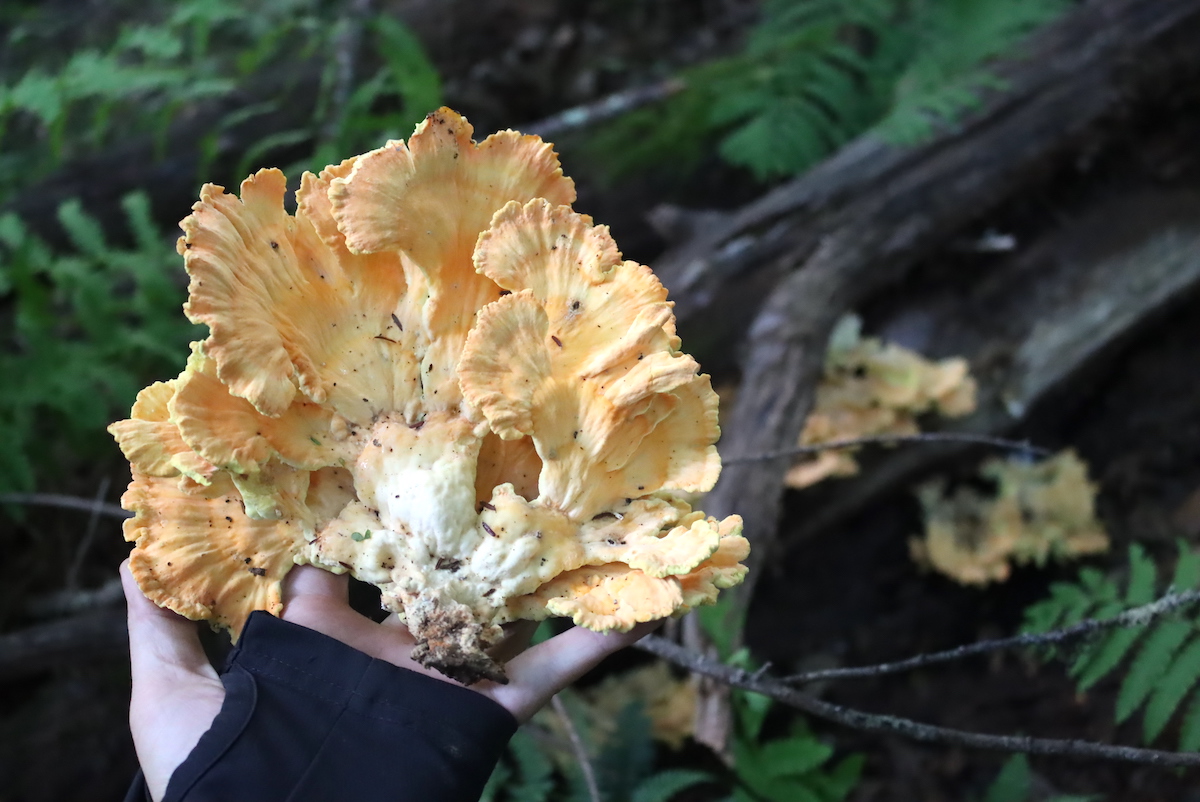
Chicken of the Woods Price
Though chicken of the woods are common woodland mushrooms, they’re also expensive. If you find them at the farmer’s market, you’ll likely pay around $20 per pound.
If you’re a full-time forager selling to restaurants and markets, finding a dependable chicken of the woods tree can mean a good payday each year. We pulled nearly 30lbs off a single tree, which would have been quite the sale if we were marketing them.
Usually, though, harvests of around 5 to 10 lbs per tree are more common.
(If you haven’t found a log that produces chicken of the woods mushrooms this year, don’t worry. They are available online from foraged market (in season), along with a great selection of other hard-to-find wild mushrooms and other wild edible plants and fruits.)
Adverse Reactions to Chicken of The Woods Mushrooms
As with any plant or mushroom, wild or cultivated, it’s always possible to have an adverse reaction to Chicken of the Woods. This particular mushroom is considered a choice edible, but only when thoroughly cooked.
Some people find they experience stomach upset eating them when they’re slightly undercooked, so be sure to thoroughly cook them before consuming them.
There have also been some reports of a tingling, lip-numbing sensation in some people, so be careful with that.
If you’ve never had them, start with small amounts before eating a whole meal of them.
Personally, I think they’re darn delicious, and I have no issue with them, but everyone’s experience (and body) is different.
Cooking Chicken of the Woods
Usually, chicken of the woods mushrooms are cooked with a lot of butter, because butter is delicious. Also because they can be a bit dry if not cooked in some kind of oil, much like a very lean chicken breast.
They’re also cooked in oil because their medicinal properties are “lipid soluble,” which means they are carried and extracted in fats. They have been shown to have anti-inflammatory and antioxidant properties, especially when consumed with lipids (fats).
My favorite way to eat them is like fried chicken, and I basically batter and fry them using my favorite fried chicken recipe. Beyond that, I’d suggest you take a look at these chicken of the woods mushroom recipes for more ideas.
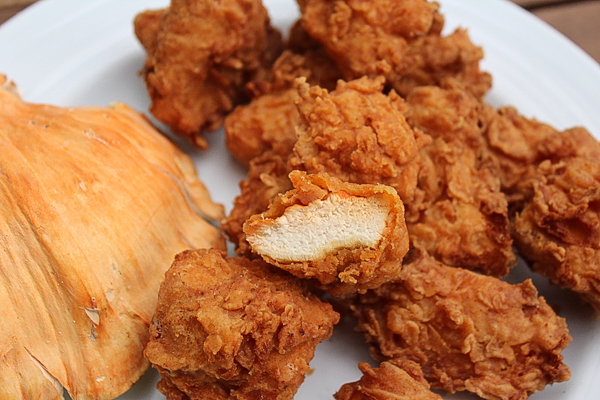
Preserving Chicken of the Woods
If you do come across a big patch of chicken of the woods mushrooms, congratulations!
Keep them refrigerated until you’re ready to use them, but even still, they won’t keep more than a week. They do need to be used quickly, or preserved.
Freezing in butter is one of the best methods, and basically, you just sautee them in a boatload of butter until they’re fully cooked, then pack them in containers completely covered in butter. They’ll be great on/in pasta dishes that way, once thawed and reheated.
The other option is pickling, and we tried a batch. I found I’m not the biggest fan of pickled mushrooms, but everyone’s tastes differ. If you’re interested, here’s a recipe for pickled chicken of the woods mushrooms.
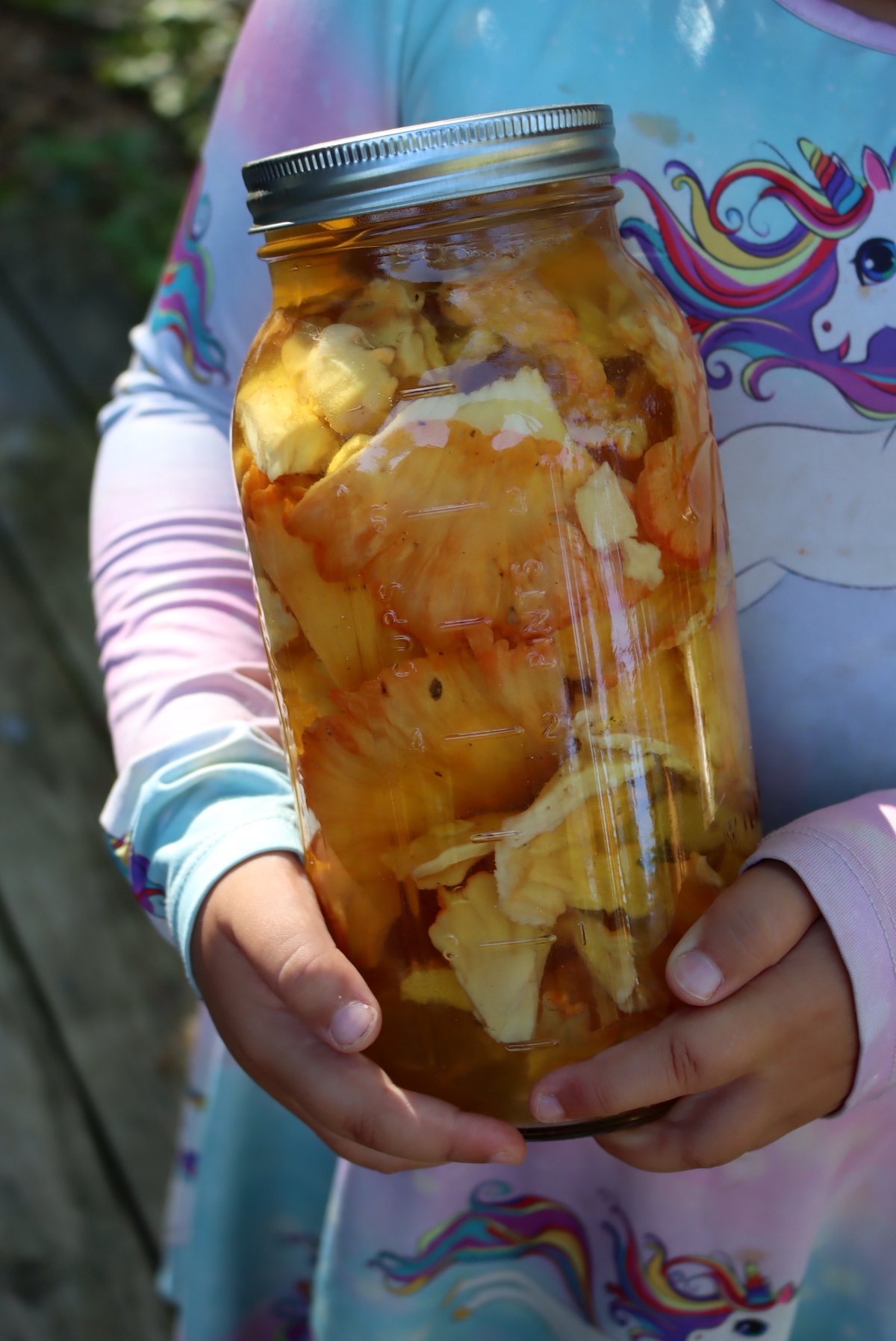
Mushroom Foraging Guides
Looking for more mushroom foraging guides?
- Morel Mushrooms
- Chaga Mushrooms
- Birch Polypore
- Tinder Polypore
- Witches Butter Mushrooms
- Puffball Mushrooms
- Shaggy Mane Mushrooms
- Reishi Mushrooms
- Turkey Tail Mushrooms
- Dryad’s Saddle
Summer Foraging Guides
Foraging more than mushrooms this season?
- 50+ Edible Wild Berries and Fruits
- 20+ Edible Weeds
- Foraging Fireweed
- Foraging Yarrow
- Foraging Plantain Herb
- Foraging Elderberries
- Foraging Wild Plums
- Foraging Chokecherry
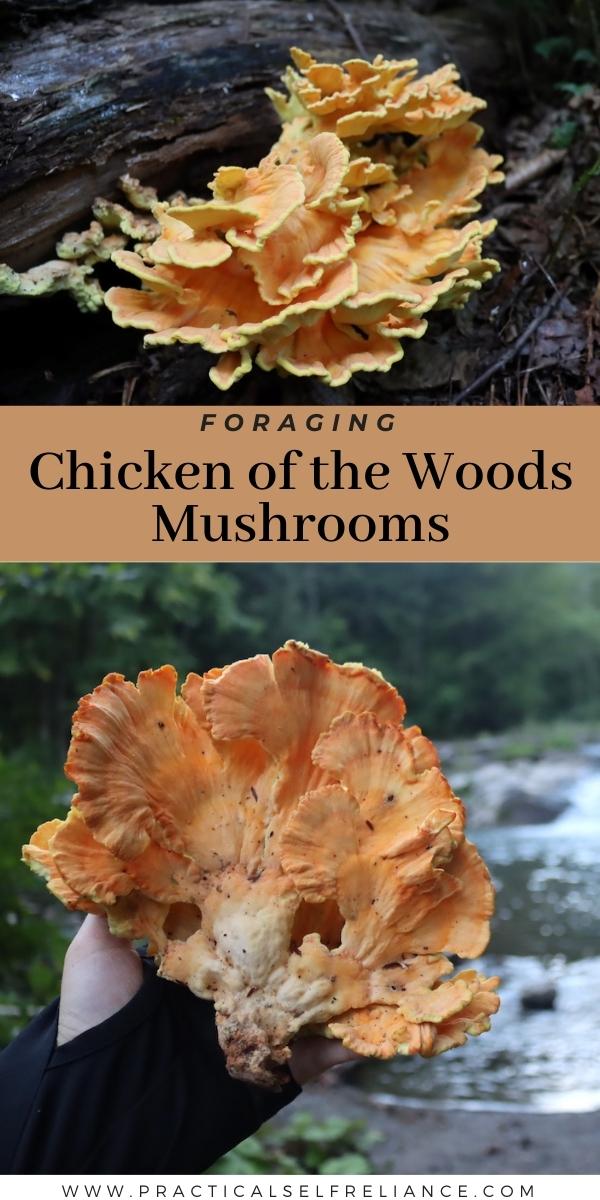

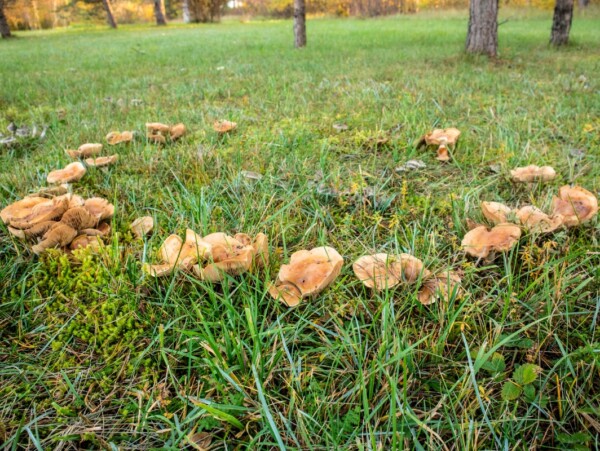
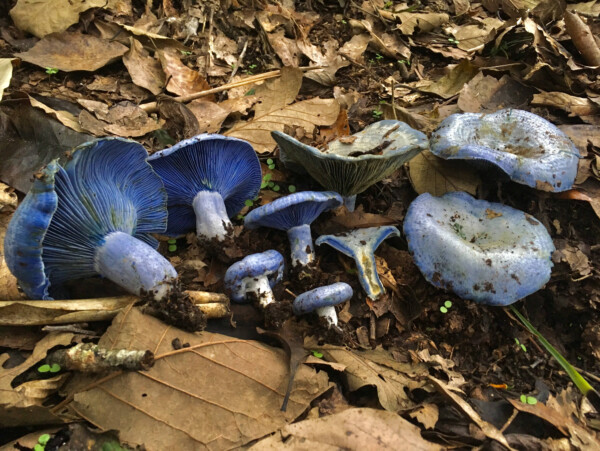
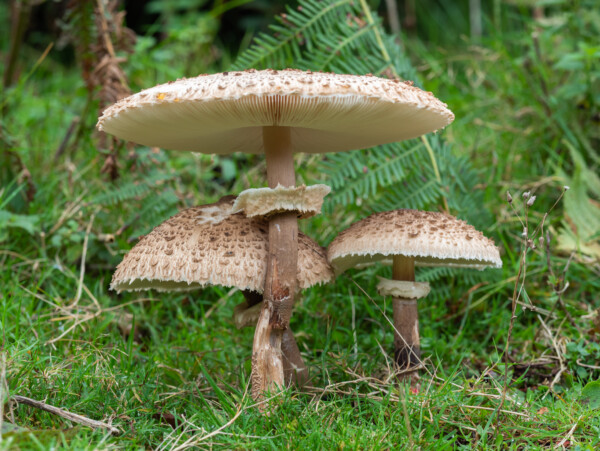










Once again you provide an abundance of wonderful information on a wild edible. Earlier this month, Sept., we came across a dead tree full of Chicken of the Woods. I had never tasted it but had seen blogs about it. We harvested some, leaving the majority for other foragers and then followed your advice about cooking them.
We cooked them in water for about 5 or so minutes, drained and cooled them, then marinaded them in a spicey Thai mixture. I allowed the flavors to infuse for 24 hours then dehydrated them.
Oh My Goodness, they are crunchy and oh so DELICIOUS. I jarred most of them, then removed the air from the jar using a pressure chamber sold by a woman on Etsy, RainCountry. They will keep for a few years using this method.
I hope that people try this method. Simply find a Thai marinade recipe that you like and your off to the crunchy, tasting snacking fest like me.
That’s great! Thanks for sharing.
Thank you thank you and thank you AGAIN AND AGAIN AND AGAIN
I CANNOT SAY IT ENOUGH
GOD BLESS TO YOU ALL
LOVE
You’re very welcome!
Bucket list!
You are hilarious! Yes, we should all avoid eating anything that resembles a squishy cow pie! 😂 I am super excited to go hunt these down. Thank you for the great information!
LOL. You’re welcome. So glad you enjoyed the post.
Just wondering. Have you tried to dehydrate or freeze dry them? Would they still taste good after you re-hydrated them?
Thanks Stay safe and God Bless…
I haven’t tried to dehydrate them (yet), but I am going to try to freeze-dry them this summer if I catch that flush again this year. I’ll put some in the dehydrator at the same time to compare them.